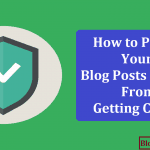One of the biggest and by far the most harmful practice encountered by Google and other search engines is the staggering amount of “duplicate content.”
It is simple as the name sounds and implies to any sort of content or material that appears on the internet on more than one source.
It translates to the fact that any bit of content that you display is being broadcasted or viewed on any other part of the web, it is regarded as duplicate content and it cripples down the search ranking.
Let’s break down this term and also look at some of the measures to prevent such practices and dilemma.
Some of the recent studies by Raven Tools across all the crawled pages had some very interesting material findings:
- 22% of duplicate page titles
- 29% of them had duplicate content being found
- 20% of the pages have lower word counts
The outcome of the study listed down a list of prescriptions to eliminate the thin or the duplicate content and rewrite them with high quality and uniqueness to increase the organic reach and climb the ladder of traffic on Google.
Contents In Page
Arguments Around:
While some may argue that the volume of duplicate content doesn’t purely impact the search ranking but it certainly doesn’t help the cause too.
The catch is that search engines such as Google are always on the charge to provide quality service and serene user experience by displaying the most relevant content on the top, to eliminate listing of multiple sites with the same content.
Duplicate content is also referred as “appreciably similar” content by search engines can really make it difficult to understand which source is most relevant to particular query thereby decreasing the view ability of majority of the content that is carded as duplicate.
Another factor that has to be taken into consideration is the amount of diluted links equity.
Inbound links are ranking factors that search engines employ but when views for the same content are split among multiple sources, it impacts the view ability of not only your website but also the credibility of the URLs on the ranking.
Identifying Duplicate Content:
As complicated is the fact that multiple sources compete for the same query, it becomes incredibly difficult to identify duplicate content.
Just to know that whether your website has any duplicate content can be really difficult. Perhaps, even when they are attempts being made to avoid it, duplicate content can subtly creep in.
In fact, majority of the duplicate content that can be found has been identified to have occurred without the knowledge of the owner owing to factors such as URL variations, HTTPS, or usage of generic product descriptions.
Methods of Identifying Duplicate Content:
-
Google Search Console:
Previously known as Webmaster Tools, it is a very helpful and fast forward tool for detecting any sort of duplicate content.
So when you jump into your site’s Console, under the menu of Search Appearance, go for HTML Improvements.
It will list a general overview of the website and also show you any significant issues regarding duplicate content with your HTML and the main things that you need to fix and be looking for are duplicate titles and descriptions.
If any results are to be found, Google will display the URL and the issue it has detected which then can be resolved.
-
Manual Site Crawl:
There are many online site crawl tools that can crawl through your website and spider the site while simultaneously cross referencing their index with all the other sources or pages available.
- Screaming Frog
- Moz Site Crawler
- Raven Tools
- Another helpful step can be just to copy, paste the flagged URL into copycape’s portal and it will then provide all the duplicate sources and have a 2 step verification. It will also help to identify whether the content is either internal or external.
-
Manual Search for Keywords and Snippets:
In some cases, special keywords of the content can help you to identify duplicate content online. It will basically then list all the sites having the exact same phrase or keyword.
It is like the more specific that you dwell into, the easier it gets to identify duplicate content.
Eliminating Duplicate Content:
Once you are able to get through the tough process of identifying and discovering duplicate content, a simple fix can be disabling the session ID’s in your URL’s or just redirecting it to a particular version of the site.
But mind you, sometimes it can be a highly complex process that will require a lot of effort.
-
Canonicalization:
It sounds as a very funky term that doesn’t come easily to the tongue. So it’s applied when you are not able to 301 redirect.
If that’s the case, it’s best to use the canonical link element that an integral part of your search engine. Canonicalization is a coding that instructs the search engines that a particular URL is the master copy of the page.
This helps in easily redirecting the traffic to the page and decreases the value of the other indexed pages. It’s a soft 301 redirect that although is a bit slower to set up, operates perfectly as well.
-
Incorrect URL’s:
Sometimes, it just happens that no matter what you do, the system just doesn’t stop building wrong URL’s. But it is possible to redirect them to the master page and eliminate duplicate content issues.
For SEO purposes, it is recommended to employ a 301 redirect.
-
Linking to the Original Content:
If you aren’t able to do any of the above listed option, then it’s better to add a backlink to the original page and via algorithm filtering Google will identify that it’s the master page.
-
Rewriting Content:
It sounds the most obvious solution but is the most tedious and time consuming option among all the others, but at the same time, the most effective.
With complex parameters in place, it can become difficult to reconstruct the whole article, line by line and hence it would be advised to have it written by a fresh perspective and a new person.








